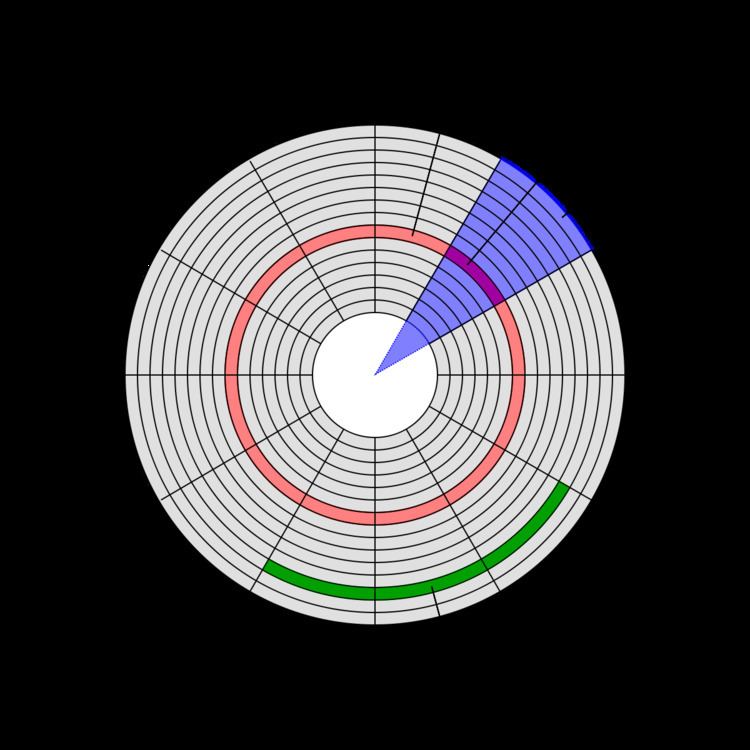 | ||
In computer disk storage, a sector is a subdivision of a track on a magnetic disk or optical disc. Each sector stores a fixed amount of user-accessible data, traditionally 512 bytes for hard disk drives (HDDs) and 2048 bytes for CD-ROMs and DVD-ROMs. Newer HDDs use 4096-byte (4 KiB) sectors, which are known as the Advanced Format (AF).
Contents
The sector is the minimum storage unit of a hard drive. Most disk partitioning schemes are designed to have files occupy a multiple of sectors regardless of the file's actual size. Files that do not fill a whole sector will have the remainder of their last sector filled with zeroes. In practice, operating systems typically operate on blocks of data, which may span multiple sectors.
Geometrically, the word sector means a portion of a disk between a center, two radii and a corresponding arc (see Figure 1, item B), which is shaped like a slice of a pie. Thus, the disk sector (Figure 1, item C) refers to the intersection of a track and geometrical sector.
In disk drives, each physical sector is made up of three basic parts, the sector header, the data area and the error-correcting code (ECC). The sector header contains information used by the drive and controller; this information includes sync bytes, address identification, flaw flag and header parity bytes. The header may also include an alternate address to be used if the data area is undependable. The address identification is used to ensure that the mechanics of the drive have positioned the read/write head over the correct location. The data area contains the recorded user data, while the ECC field contains codes based on the data field, which are used to check and possibly correct errors that may have been introduced into the data.
History
The standard sector size of 512 bytes for magnetic disks was established with the inception of the hard disk drive in 1956. In 2000, through a coordinated effort organized by the industry trade organization, International Disk Drive Equipment and Materials Association (IDEMA), leading hardware and software companies started work to define the implementation and standards that would govern sector size formats exceeding 512 bytes to accommodate future increases in data storage capacities.
In the 1970s IBM introduced the Direct Access Storage Device (DASD) with fixed-block architecture using sizes of 512, 1024, 2048, or 4096 bytes. Cray Research had an 819 disk controller in 1975 that transferred 512 64-bit words (4096 bytes) per sector. Later hard disk drives supporting 1,024-byte sectors began to be integrated into consumer electronics devices such as portable media players and digital video cameras. However, by far the majority of hard drives shipped up to the start of the 2010s still used the traditional 512-byte sector size.
By the end of 2007, Samsung and Toshiba began shipments of 1.8-inch hard disk drives with 4096 byte sectors, the sector size designated as the next standard format for all hard drives. In 2010, the International Disk Drive Equipment and Materials Association (IDEMA) completed the Advanced Format standard for 4096 sector drives, setting the date for the transition from 512 to 4096 byte sectors as January 2011 for all manufacturers, and Advanced Format drives soon became prevalent.
Sectors versus blocks
While sector specifically means the physical disk area, the term block has been used loosely to refer to a small chunk of data. Block has multiple meanings depending on the context. In the context of data storage, a filesystem block is an abstraction over disk sectors possibly encompassing multiple sectors. In other contexts, it may be a unit of a data stream or a unit of operation for a utility. For example, the Unix program dd allows one to set the block size to be used during execution with the parameter bs=bytes. This specifies the size of the chunks of data as delivered by dd, and is unrelated to sectors or filesystem blocks.
In Linux, disk sector size can be determined with fdisk -l | grep "Sector size" and block size can be determined with blockdev --getbsz /dev/sda.
Zone bit recording
If a sector is defined as the intersection between a radius and a track, as was the case with early hard drives and most floppy disks, the sectors towards the outside of the disk are physically longer than those nearer the spindle. Because each sector still contains the same number of bytes, the outer sectors have lower bit density than the inner ones, which is an inefficient use of the magnetic surface. The solution is zone bit recording, wherein the disk is divided into zones, each encompassing a small number of contiguous tracks. Each zone is then divided into sectors such that each sector has a similar physical size. Because outer zones have a greater circumference than inner zones, they are allocated more sectors. This is known as zoned bit rate.
A consequence of zone bit recording is that contiguous reads and writes are noticeably faster on outer tracks (corresponding to lower block addresses) than on inner tracks, as more bits pass under the head with each rotation; this difference can be 25% or more.
Advanced Format
Hard disk drive manufacturers identified the need for large sector sizes to deliver higher capacity points along with improved error correction capabilities. The traditional means of achieving storage capacity increases, which averaged 44 percent per year from 2000 to 2009, were projected to stagnate without revolutionary breakthroughs in magnetic recording system technologies. However, by modifying the length of the data field through the implementation of Advanced Format using 4096-byte sectors, hard disk drive manufacturers could increase the efficiency of the data surface area by five to thirteen percent while increasing the strength of the ECC.
